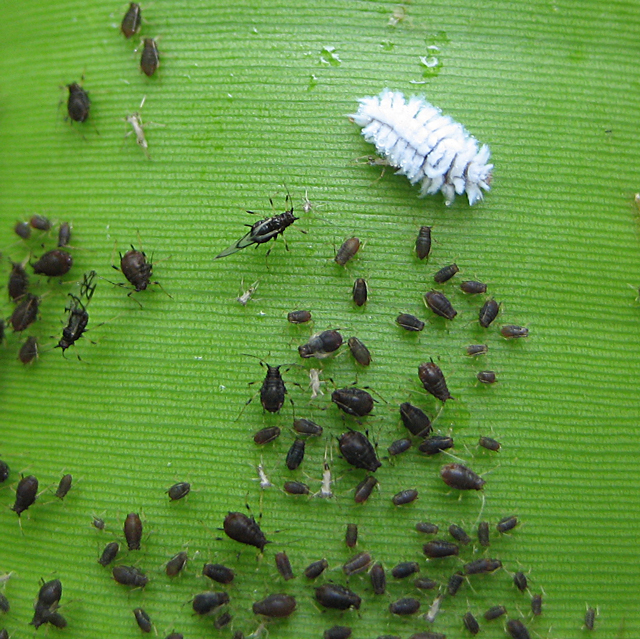|

February 2009. A member from Pakistan asked if the aphid in the photo was Pentalonia nigronervosa, and how to control it.
Members agree that it looked very close to the banana aphid, Pentalonia nigronervosa Coquerel, the known vector of banana bunchy top virus (BBTV). However, the wing venation pattern is not sufficiently clear to be certain.see http://pick5.pick.uga.edu/mp/20q?search=Pentalonia+nigronervosa for comparison.
In the picture, there is also a larva that is probably Scymnus sp. or Cryptogonus sp. It is an effective predator of the aphid and could be mass reared for biological control.
In Thailand, there is no BBTV, it was erroneously reported. However, Pentalonia nigronervosa is present. An exploration of its natural enemies by Hawaian entomologist with Thai entomologists in 2002 resulted in the introduction of Scymnus pleikuensis, S quadrillum and Cryptogonus lepidus to Hawaii for trial in biological control of this banana aphid.
Pentalonia nigronervosa is almost always closely attended by ants, which defend the aphids from predators and parasites, and spread the aphids to other feeding sites. Control of ants in the plantation should greatly reduce the aphid problem.
Use of pesticides would only be effective against a small proportion of the aphid population, as P nigronervosa lives mainly underneath layers of leaves on the pseudostem where contact insecticides will not reach the insects. Contact insecticide would kill any predators and parasites present and might make the aphid problem worse. The most effective long-term management method is biological control. (Editor: for control BBTV, the usual method is regular scouting to identify infected bananas and then careful removal using a combination of herbicide and insecticide to kill the diseased banana and also prevent the aphids with virus from spreading the disease).
See: http://www.extento.hawaii.edu/Kbase/crop/Type/pentalon.htm.
Comments on control are also given at:
http://www.pestnet.org/Summaries/Pests/PestManagement/Biologicalcontrol/Pentalon
ianigronervosaBBTVvector/tabid/1202/Default.
See also: http://cat.inist.fr/?aModele=afficheN&cpsidt=1357003.
|
